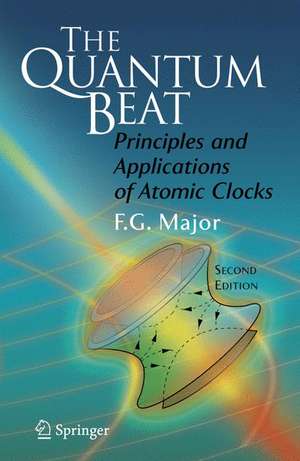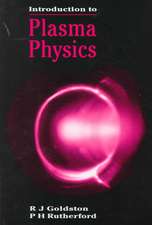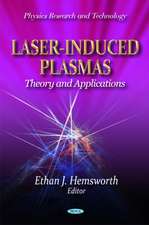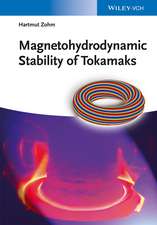The Quantum Beat: Principles and Applications of Atomic Clocks
Autor Fouad G. Majoren Limba Engleză Hardback – 6 iun 2007
This edition retains the essentially didactic approach to the treatment of the development of atomic clocks in the first edition, but brings up to date the extraordinary developments in recent years, culminating in clocks based on quantum resonance at optical frequency in individual ions confined in miniature electromagnetic traps. These, together with advances in the generation of wide-band coherent frequency combs spanning the spectrum as far as the optical range, has made possible the direct measurement of phenomena occurring at optical frequencies! As a result of these recent advances, in addition to the time-based GPS and LORAN C navigation systems treated in the first edition, other important applications of a fundamental scientific interest have become feasible. These include satellite-borne tests of the theory of general relativity and the equivalence principle on which it is based.
| Toate formatele și edițiile | Preț | Express |
|---|---|---|
| Paperback (1) | 498.91 lei 43-57 zile | |
| Springer – 29 oct 2010 | 498.91 lei 43-57 zile | |
| Hardback (1) | 653.65 lei 43-57 zile | |
| Springer – 6 iun 2007 | 653.65 lei 43-57 zile |
Preț: 653.65 lei
Preț vechi: 769.00 lei
-15% Nou
Puncte Express: 980
Preț estimativ în valută:
125.12€ • 135.95$ • 105.16£
125.12€ • 135.95$ • 105.16£
Carte tipărită la comandă
Livrare economică 21 aprilie-05 mai
Preluare comenzi: 021 569.72.76
Specificații
ISBN-13: 9780387695334
ISBN-10: 0387695338
Pagini: 479
Ilustrații: XII, 482 p. 234 illus.
Dimensiuni: 155 x 235 x 27 mm
Greutate: 0.79 kg
Ediția:2nd ed. 2007
Editura: Springer
Colecția Springer
Locul publicării:New York, NY, United States
ISBN-10: 0387695338
Pagini: 479
Ilustrații: XII, 482 p. 234 illus.
Dimensiuni: 155 x 235 x 27 mm
Greutate: 0.79 kg
Ediția:2nd ed. 2007
Editura: Springer
Colecția Springer
Locul publicării:New York, NY, United States
Public țintă
ResearchCuprins
Celestial and Mechanical Clocks.- Oscillations and Fourier Analysis.- Oscillators.- Quartz Clocks.- The Language of Electrons, Atoms, and Quanta.- Magnetic Resonance.- Corrections to Observed Atomic Resonance.- The Rubidium Clock.- The Classical Cesium Standard.- Atomic and Molecular Oscillators: Masers.- The Hydrogen Maser.- The Confinement of Particles in Fields.- Isolated Ion Clock: A New Approach.- Optical Frequency Oscillators: Lasers.- Laser Systems.- Laser Cooling of Atoms and Ions.- Application of Lasers to Microwave Standards.- Optical Standards and Measurement.- Applications: Time-Based Navigation.- Atomic Clocks and Fundamental Physics.
Recenzii
From the reviews of the second edition:
"This revision is a very complete account of the evolution of frequency and time measurement with emphasis on the development of atomic clocks. … The 20 chapters include a wide range of topics starting with a brief history of time measurements. … Complete index, extensive references, list of suggested readings by topic. Summing Up: Recommended. Lower-division undergraduates through professionals; two-year technical program students." (R. L. Stearns, CHOICE, Vol. v4 (3), November, 2007)
"This revision is a very complete account of the evolution of frequency and time measurement with emphasis on the development of atomic clocks. … The 20 chapters include a wide range of topics starting with a brief history of time measurements. … Complete index, extensive references, list of suggested readings by topic. Summing Up: Recommended. Lower-division undergraduates through professionals; two-year technical program students." (R. L. Stearns, CHOICE, Vol. v4 (3), November, 2007)
Notă biografică
Fouad G. Major pioneered the application of ion field confinement to microwave spectroscopy. He made the first observation of microwave resonance in trapped mercury ions as a reference for a spacecraft atomic clock at NASA laboratory(1969). Awarded the NASA "Apollo Achievement Award" 1970 and was guest researcher at the Laboratoire de l’Horloge Atomique in Orsay, France.
Textul de pe ultima copertă
This work attempts to convey a broad understanding of the physical principles underlying the workings of these quantum-based atomic clocks, with introductory chapters placing them in context with the early development of mechanical clocks and the introduction of electronic time-keeping as embodied in the quartz-controlled clocks. While the book makes no pretense at being a history of atomic clocks, it nevertheless takes a historical perspective in its treatment of the subject.
Intended for nonspecialists with some knowledge of physics or engineering, The Quantum Beat covers a wide range of salient topics relevant to atomic clocks, treated in a broad intuitive manner with a minimum of mathematical formalism. Detailed descriptions are given of the design principles of the rubidium, cesium, hydrogen maser, and mercury ion standards; the revolutionary changes that the advent of the laser has made possible, such as laser cooling, optical pumping, the formation of "optical molasses," and the cesium "fountain" standard; and the time-based global navigation systems, Loran-C and the Global Positioning System. Also included are topics that bear on the precision and absolute accuracy of standards, such as noise, resonance line shape, the relativistic Doppler effect as well as more general relativistic notions of time relevant to synchronization of remote clocks, and time reversal symmetry.
This edition retains the essentially didactic approach to the treatment of the development of atomic clocks in the first edition, but brings up to date the extraordinary developments in recent years, culminating in clocks based on quantum resonance at optical frequency in individual ions confined in miniature electromagnetic traps. These, together with advances in the generation of wide-band coherent frequency combs spanning the spectrum as far as the optical range, has made possible the direct measurement of phenomena occurring at optical frequencies! As a result of theserecent advances, in addition to the time-based GPS and LORAN C navigation systems treated in the first edition, other important applications of a fundamental scientific interest have become feasible. These include satellite-borne tests of the theory of general relativity and the equivalence principle on which it is based.
As with the first edition, the book is intended for students and non-specialists; hence the material is not rigidly formal, is mostly self-contained, and presented in a broad intuitive manner with a minimum of mathematical formalism.
Intended for nonspecialists with some knowledge of physics or engineering, The Quantum Beat covers a wide range of salient topics relevant to atomic clocks, treated in a broad intuitive manner with a minimum of mathematical formalism. Detailed descriptions are given of the design principles of the rubidium, cesium, hydrogen maser, and mercury ion standards; the revolutionary changes that the advent of the laser has made possible, such as laser cooling, optical pumping, the formation of "optical molasses," and the cesium "fountain" standard; and the time-based global navigation systems, Loran-C and the Global Positioning System. Also included are topics that bear on the precision and absolute accuracy of standards, such as noise, resonance line shape, the relativistic Doppler effect as well as more general relativistic notions of time relevant to synchronization of remote clocks, and time reversal symmetry.
This edition retains the essentially didactic approach to the treatment of the development of atomic clocks in the first edition, but brings up to date the extraordinary developments in recent years, culminating in clocks based on quantum resonance at optical frequency in individual ions confined in miniature electromagnetic traps. These, together with advances in the generation of wide-band coherent frequency combs spanning the spectrum as far as the optical range, has made possible the direct measurement of phenomena occurring at optical frequencies! As a result of theserecent advances, in addition to the time-based GPS and LORAN C navigation systems treated in the first edition, other important applications of a fundamental scientific interest have become feasible. These include satellite-borne tests of the theory of general relativity and the equivalence principle on which it is based.
As with the first edition, the book is intended for students and non-specialists; hence the material is not rigidly formal, is mostly self-contained, and presented in a broad intuitive manner with a minimum of mathematical formalism.
Caracteristici
Intended for non-specialists Treats the material in a broad intuitive manner Covers a wide range of relevant topics Focuses on electronic time keeping Examines the revolutionary changes made possible by laser cooling and optical pumping Discusses the application to global navigation: in particular, GPS and Loran Unique, in that no other books cover the physics of atomic clocks Includes supplementary material: sn.pub/extras















